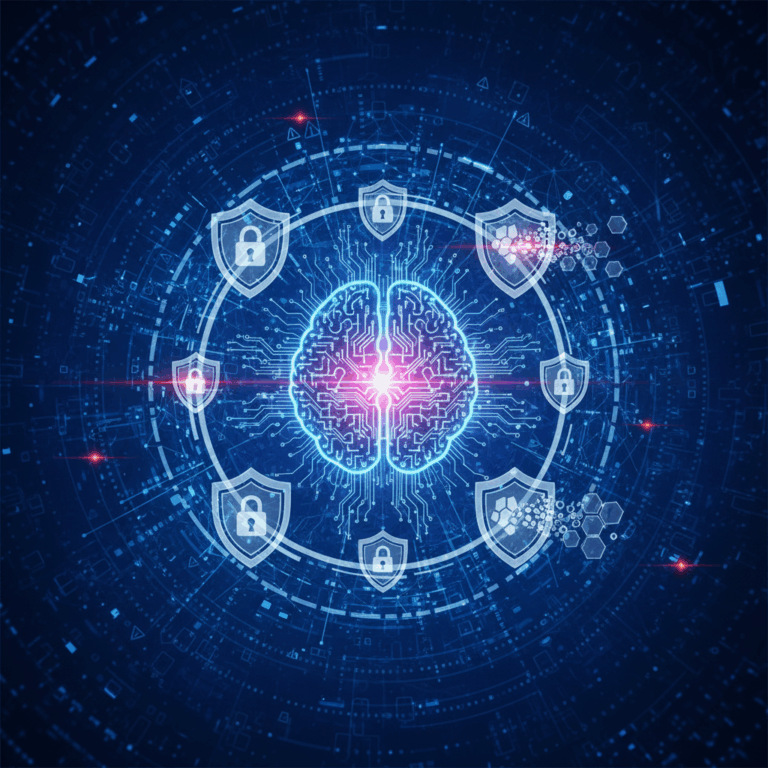AI Fundamentals in Cybersecurity
Artificial intelligence is revolutionizing cybersecurity by enhancing the detection and prevention of cyber threats through advanced machine learning methods. These systems analyze huge data volumes quickly, spotting hidden threats early.
By learning typical network behaviors, AI identifies deviations that signal potential attacks. This proactive detection enables faster responses, minimizing damage from malware and phishing attempts effectively.
AI’s ability to process data in real time supports continuous monitoring and rapid reaction, crucial in defending against increasingly sophisticated cyber threats in today’s digital environment.
Machine Learning Algorithms for Threat Detection
Machine learning algorithms power AI’s ability to detect cybersecurity threats by analyzing patterns across large datasets. They learn normal behavior to differentiate between legitimate activity and potential attacks.
These algorithms improve over time, adapting to new threats that bypass traditional security methods. This continuous learning is critical for identifying zero-day vulnerabilities and sophisticated malware.
By automating threat detection, machine learning reduces the reliance on manual monitoring, allowing security teams to focus on strategic responses to complex cyber incidents.
Real-Time Data Analysis and Pattern Recognition
Real-time analysis enables AI to process network traffic and system logs instantly, identifying suspicious patterns before breaches occur. This immediacy strengthens overall defense capabilities.
Pattern recognition helps detect anomalies like unusual login attempts or irregular data flows, flagging them for further investigation. This proactive approach effectively anticipates and mitigates threats.
Combining real-time data scrutiny with intelligent pattern recognition allows AI to operate continuously, ensuring no harmful activity goes unnoticed in rapidly changing environments.
AI Techniques for Detecting Cyber Threats
AI techniques in cybersecurity focus on detecting threats by continuously monitoring network and endpoint activity. This vigilance allows swift detection of any abnormalities indicating cyber attacks.
Through intelligent analysis, AI systems identify suspicious behaviors and anomalies that deviate from typical patterns, enabling early warning and proactive defense against sophisticated threats.
Automation also plays a key role, as AI detects malware, ransomware, and phishing attempts rapidly, reducing the chance for attackers to exploit vulnerabilities undetected.
Continuous Monitoring of Network and Endpoint Activity
AI systems continuously scan network traffic and endpoint devices to establish baselines of normal behavior. This constant monitoring is essential for recognizing unusual activities immediately.
By comparing real-time data against learned patterns, AI can detect unauthorized access or malicious processes early, increasing the chances of thwarting attacks before damage occurs.
This approach reduces manual oversight requirements and enhances threat visibility across complex infrastructures, facilitating timely incident response.
Identifying Anomalies and Suspicious Behaviors
AI employs advanced algorithms to spot anomalies that may indicate cyber threats, such as irregular login attempts or unexpected data transfers. These deviations are critical warning signs.
Detecting suspicious behaviors early helps prevent escalation by prompting investigations or automated responses to isolate risks and limit attack surfaces.
Such nuanced detection outperforms traditional signature-based methods, as AI adapts to evolving threats and uncovers hidden malicious activities effectively.
Automated Detection of Malware, Ransomware, and Phishing
AI automates the identification of malware, ransomware, and phishing attacks using signature analysis and behavior-based models. This ensures rapid threat recognition and containment.
By analyzing file characteristics, network patterns, and email content, AI uncovers malicious intent, preventing compromise from sophisticated cyberattacks.
Automation reduces response times and helps maintain system integrity by blocking threats before they spread, significantly enhancing security posture.
AI-Driven Response and Prevention Strategies
AI enhances cybersecurity by not only detecting threats but also enabling swift, automated responses that limit damage. These systems act quickly to block attacks and isolate compromised components.
Proactive defense is strengthened through continuous vulnerability scanning, allowing AI to identify and address weaknesses before attackers exploit them.
Together, these strategies improve an organization’s resilience against cyber threats by combining rapid reaction with ongoing risk reduction.
Automated Threat Mitigation Actions
Upon detecting a cyber threat, AI systems can trigger immediate actions such as blocking malicious IP addresses, quarantining infected devices, or shutting down compromised accounts.
This automated response minimizes the time attackers have to operate, reducing potential damage and preventing further spread of malware or unauthorized access.
Such fast mitigation is crucial in limiting impact during incidents like ransomware attacks, where every second counts to protect data and systems.
Vulnerability Scanning and Proactive Defense
AI-driven vulnerability scanning continuously evaluates systems for security weaknesses, helping organizations prioritize patches and remediation efforts effectively.
This proactive approach enables early identification of potential entry points for attackers, reducing risk through timely defenses before exploitation occurs.
By automating this process, AI ensures ongoing vigilance and adaptability in facing rapidly evolving cybersecurity threats.
Benefits and Limitations of AI in Cybersecurity
The integration of AI in cybersecurity offers significant benefits, including enhanced scalability and speed in threat detection and response. However, it also presents challenges that must be managed carefully for optimal effectiveness.
While AI improves accuracy and efficiency, the need for human oversight remains critical. Managing false positives and ensuring appropriate interventions are essential to maintaining robust cybersecurity defenses.
Understanding both the strengths and limits of AI helps organizations leverage its power effectively and mitigate risks in an increasingly complex cyber threat environment.
Scalability and Speed of AI Systems
AI systems excel in processing vast amounts of data quickly, enabling near real-time threat identification across diverse networks and endpoints. This scalability surpasses human capabilities.
The rapid analysis and automated responses lessen the window of opportunity for cyber attackers, minimizing potential damage by acting faster than manual methods allow.
Such speed and scalability are vital as cyber threats grow in volume and sophistication, requiring continuous monitoring beyond traditional limits.
Human Oversight and Managing False Positives
Despite AI’s advantages, human expertise is crucial in reviewing AI-generated alerts to avoid unnecessary disruptions caused by false positives. This balance ensures accurate threat response.
Security teams interpret the context of flagged incidents, decision-making that AI alone cannot fully replicate, especially with complex or novel attack vectors.
Ongoing collaboration between AI systems and human analysts enhances cybersecurity outcomes by combining machine efficiency with human judgment and intuition.






